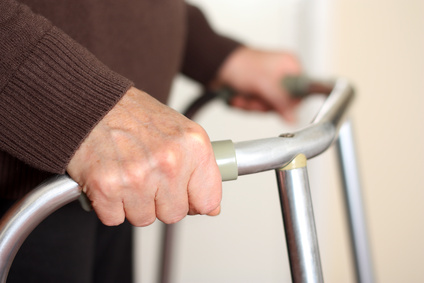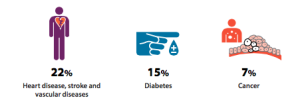The elderly refers to people over the age of 65. Australia’s population is aging (increased percentage of elderly Australians) and it is important to understand the health of elderly Australians and the determinants of their health if it is going to be addressed adequately. Chronic diseases and level of independence are of particular importance for the elderly.
The nature and extent of the health inequities
The elderly are most affected by chronic disease, with 78% of the elderly suffering from either: asthma, type 2 diabetes, coronary heart disease, cerebrovascular disease, arthritis, osteoporosis, COPD, depression or hypertension. What’s worse is that half of these have to cope with 5 or more chronic diseases. The most common diseases in the elderly are: vision or hearing impairment (35%), arthritis (49%) and musculoskeletal problems (such as hip and knee replacements), hypertension (38%), and high cholesterol. Over 1 in 5 elderly people have heart disease, stroke. or vascular disease, which all result from atherosclerosis. The elderly also have higher rates of diabetes (15%) and cancer (7%0).
70% of people who suffer from a stroke are elderly and more than 15% of coronary heart disease occurs in the elderly. Diabetes is more common in men than women, and affects 20% of he elderly. With the survival rate of cancers rising and the continuing aging of Australia’s population, recurrence of cancers is increasing, which raises the likelihood of cancer being a comorbid disease.
Another major disease for the elderly is dementia, which is on the rise in Australia. 93% of people suffering from dementia are elderly. 1/3 of male and 2/3 of female injury deaths occur amongst the elderly. The elderly also have the highest rate of injury-relates hospitalisations. Falls are a common cause of these injuries, often producing fractures or other injuries. Falls are more frequent for females than males amongst the elderly.
The aged population growth of Australia is predicted to continue, which will increase the prevalence of disability as the elderly have higher rates of disability, with over 50% having a disability.
Despite the higher rates of chronic diseases 2/3 of the elderly rate their health as good or better.
The sociocultural, socioeconomic and environmental determinants
Sociocultural determinants include: family, peers, media, religion and culture. Among he elderly family becomes very important for health and social activity. The elderly are often cared for by their children when carers are needed and it can be difficult for families to decide when it is time to change roles, and families can also be hesitant in being the main carer, as it often comes with a financial cost. The elderly also begin to lose friends as they age reducing their support networks.
Socioeconomically, the health of the elderly is affected by their reduced employment. Though many look forward to retirement, work is a place where friendships are developed and provides a sense of achievement and improves self-worth. As the elderly reduce their workloads, or retire their support networks are reduced and their mental health is affected. Retirement often brings with it a reduction in income, which restricts choice of health services. There is an increase in volunteer work amongst the elderly, and those who participate report increased mental health and higher rates of social activity.
Environmental determinants include access to health services and geographical location. Due to the increased incidence of chronic illnesses and disability amongst the elderly, access to services can become difficult because the elderly need to attend specialist services that may not be available in their local areas. There is also a reduced level of independency amongst the elderly, which reduces access to services. The increased number of retirement villages, hostels and nursing homes for the elderly helps improve access to services as often these locations provide services on a regular basis, or a least transport to health centres.
Other risk factors amongst the elderly include a decrease in vegetable consumption, increased inactivity levels, higher rates of smoking and decreased independence.
The roles of individuals, communities and governments in addressing the health inequities
Elderly individuals can take responsibility for their own and others health by making and supporting healthier lifestyle choices. Quiting smoking, increasing physical activity levels and eating a healthy balanced diet will improve health outcomes for the elderly. The elderly can also increase social activity by increasing contact with family, joining a club, moving into a retirement village or joining a volunteer organisation.
Communities provide many health services to assist the elderly. Meals on Wheels provide food delivery to people who are less mobile and unable to access food services easily. Retirement villages often offer a range of services to the elderly living there, including: social activities, GP home visits and transportation. Other home services will help clean houses and mow lawns for the elderly, such as Australian Unity Home Care – many of which are funded by the government.
The Australian Governments main focus for improving the health of the elderly is to prevent or reduce chronic diseases as much as possible. This includes promoting good health across the lifespan, as many health conditions are not a result of aging, but of lifestyle choices. The Government seeks to enable healthy ageing by maintaining and improving the health and quality of life amongst the elderly. This is done through improved management of chronic conditions and the use of broader strategies to enable healthy and active aging. Healthy aging requires the elderly to engage and promote healthy behaviours as well as adapt well to changing circumstances. The Government also seeks to enable the elderly to participate economically and socially in the community. Better health outcomes are associated with employment, thus increased health enables greater employment, and employment enables greater health outcomes. The Government also seeks to enhance the efficiency of the health-care system. Coordinating care and safe use of medicine can help reduce risks that come with duplication of tests and medical records not being available at the time of care. Further efficiency in the interaction with aged care and efforts to ensure relevant and appropriate care will also improve the health of the elderly.


